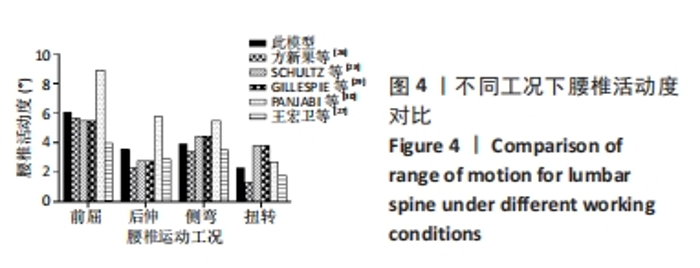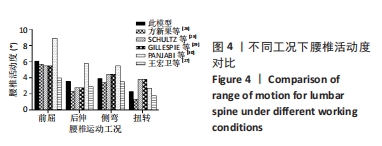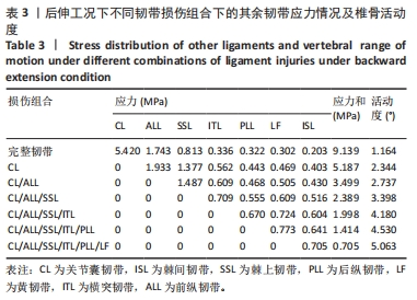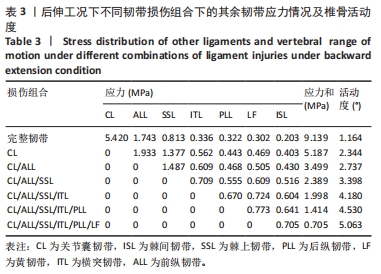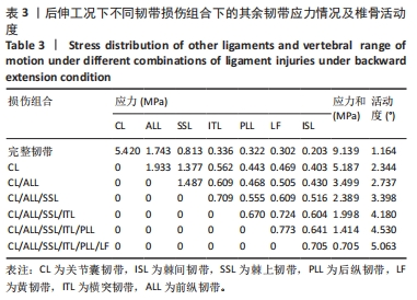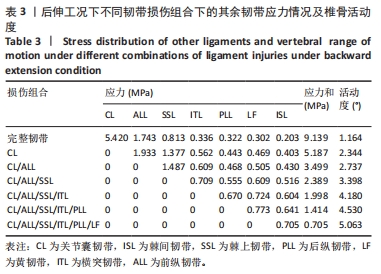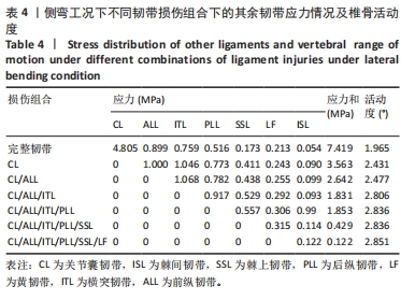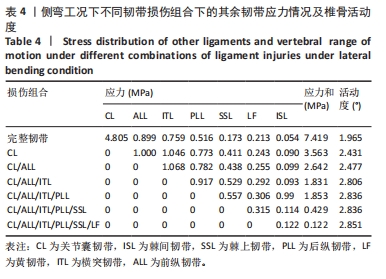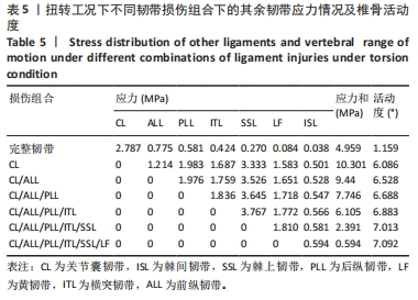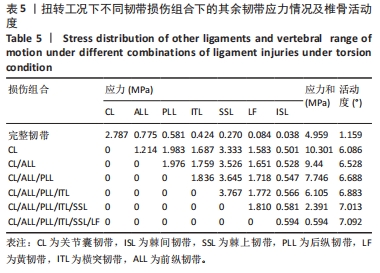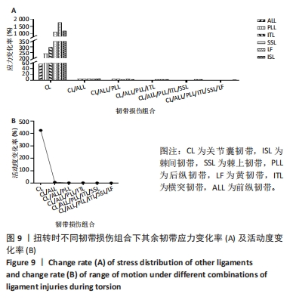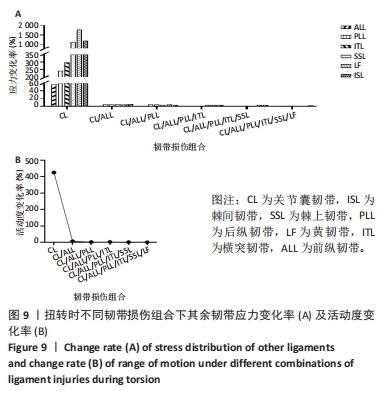Chinese Journal of Tissue Engineering Research ›› 2024, Vol. 28 ›› Issue (33): 5249-5256.doi: 10.12307/2024.658
Effect of total ligament superimposed injury on biomechanical characteristics of the lumbar spine
Wang Duoduo1, Lyu Jie1, Guo Panjing1, Ding Lijun2, Cao Jinfeng3, Zhou Nan4, Lyu Qiang4
- 1College of Rehabilitation Sciences, 2School of Medical Instruments, Shanghai University of Medicine & Health Sciences, Shanghai 201318, China; 3Periodicals Agency of Shanghai University, Shanghai 200444, China; 4Department of Massage, Yueyang Hospital of Integrated Traditional Chinese and Western Medicine, Shanghai University of Traditional Chinese Medicine, Shanghai 200437, China
-
Received:2023-08-10Accepted:2023-10-12Online:2024-11-28Published:2024-01-30 -
Contact:Lyu Jie, MD, Associate professor, Master’s supervisor, College of Rehabilitation Sciences, Shanghai University of Medicine & Health Sciences, Shanghai 201318, China -
About author:Wang Duoduo, Master candidate, College of Rehabilitation Sciences, Shanghai University of Medicine & Health Sciences, Shanghai 201318, China -
Supported by:National Natural Science Foundation of China (General Program), No. 82074571 (to ZN); Shanghai Style Traditional Chinese Medicine School Inheritance and Innovation Team Construction Project, No. 2021LPTD-007 (to LJ)
CLC Number:
Cite this article
Wang Duoduo, Lyu Jie, Guo Panjing, Ding Lijun, Cao Jinfeng, Zhou Nan, Lyu Qiang. Effect of total ligament superimposed injury on biomechanical characteristics of the lumbar spine[J]. Chinese Journal of Tissue Engineering Research, 2024, 28(33): 5249-5256.
share this article
Add to citation manager EndNote|Reference Manager|ProCite|BibTeX|RefWorks
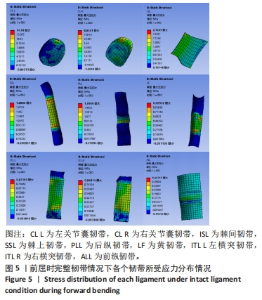
因而此模型是有效且可靠的模型,可以用于进行腰椎生物力学的相关研究。此外,相比于四面体网格,六面体网格更易收敛且密度更小[31],此模型中主要研究对象韧带及关键结构椎间盘采用六面体网格,其余结构使用四面体网格,既能使结果更加精确,又不会增加过多的计算时间。 2.2 韧带的叠加损伤 在前屈、后伸、侧弯、扭转4种工况下,对腰椎施加5 N·m的力矩,分别得到了正常完整韧带时各个韧带所受应力的最大值,前屈时完整韧带所受应力由大到小的顺序为:关节囊韧带/棘间韧带/棘上韧带/后纵韧带/黄韧带/横突韧带/前纵韧带(图5);后伸时完整韧带所受应力由大到小的顺序为:关节囊韧带/前纵韧带/棘上韧带/横突韧带/后纵韧带/黄韧带/棘间韧带;侧弯时韧带所受应力由大到小的顺序为:关节囊韧带/前纵韧带/横突韧带/后纵韧带/棘上韧带/黄韧带/棘间韧带;扭转时韧带所受应力由大到小的顺序为:关节囊韧带/前纵韧带/后纵韧带/横突韧带/棘上韧带/黄韧带/棘间韧带。按此顺序依次进行韧带的去除,每一种工况下都得到了去除韧带的6种组合,得到了每去除一根韧带后,其余韧带的应力情况以及椎骨的活动度。"
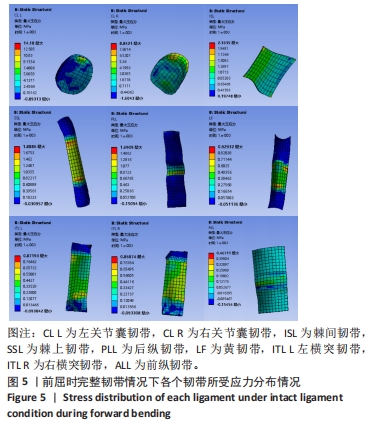
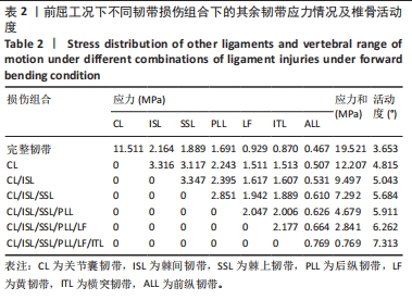
应力结果显示,除了侧弯时去除横突韧带后的棘间韧带,其余的所有情况下,每去除一根韧带,剩余韧带应力都在增加;正常完整韧带情况下,4种工况都是关节囊韧带所受应力最大,关节囊韧带所受应力由大到小的工况顺序依次为前屈、后伸、侧弯、扭转;由表2-5中的应力和可知,前屈和扭转时全部韧带所受应力之和最大。椎骨活动度结果显示,4种工况下,每去除一根韧带,椎骨活动度都在增加,韧带去除最多时,活动度也最大;完整韧带情况下,前屈时活动度最大,为3.653°,扭转时活动度最小,为1.159°;侧弯情况下,从完整韧带到只剩一根韧带时,活动度的变化最小,前后之差仅为0.886°,扭转情况下,从完整韧带到只剩一根韧带时,活动度的变化最大,为5.724°。"
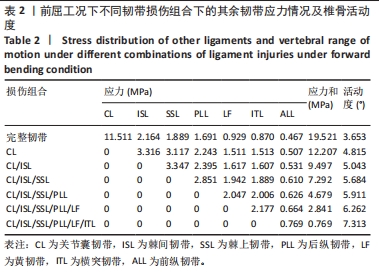
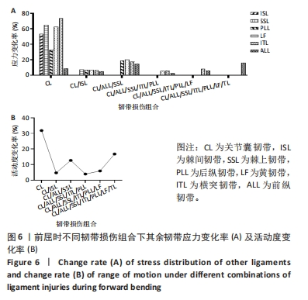
为进一步深层次研究韧带损伤对腰椎稳生物力学特性影响的机制,进行韧带应力变化率和椎骨活动度变化率的分析,得到每去除一根韧带后,其余韧带相对于前一组韧带损伤组合的应力变化率,以及每去除一根韧带后,相对于前一韧带组合下的椎骨活动度变化率。在前屈情况下,按应力由大到小顺序依次进行韧带的去除,去除韧带的6个组合为:完整韧带、关节囊韧带、关节囊韧带/棘间韧带、关节囊韧带/棘间韧带/棘上韧带、关节囊韧带/棘间韧带/棘上韧带/后纵韧带、关节囊韧带/棘间韧带/棘上韧带/后纵韧带/黄韧带、关节囊韧带/棘间韧带/棘上韧带/后纵韧带/黄韧带/横突韧带。图6A的应力变化率显示,去除第一根韧带关节囊韧带后,剩余所有韧带应力变化率平均值最大,其次是去除棘上韧带后;棘上韧带、后纵韧带、黄韧带、横突韧带的应力变化率在去除关节囊韧带后最大,前纵韧带的应力变化率在去除横突韧带后最大;棘上韧带和后纵韧带在去除棘间韧带后应力变化率最小,关节囊韧带、横突韧带和前纵韧带在去除后纵韧带后应力变化率最小。图6B的活动度变化率结果显示,去除关节囊韧带后,活动度变化率最大,为31.820%;去除后纵韧带后,活动度变化率最小,为3.996%;去除棘上韧带和去除横突韧带后,活动度也出现了明显的增大。"
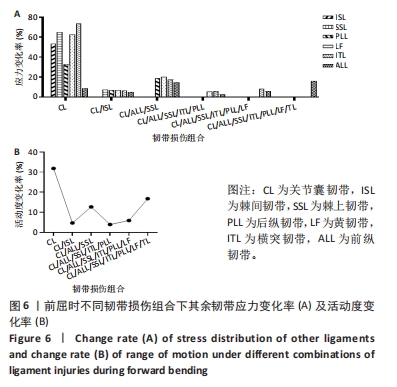
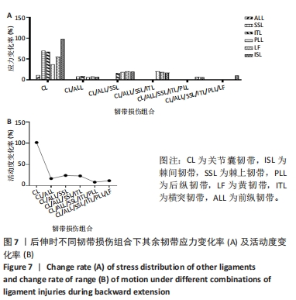
在后伸情况下,按应力由大到小顺序依次进行韧带的去除,去除韧带的6个组合为:完整韧带、关节囊韧带、关节囊韧带/前纵韧带、关节囊韧带/前纵韧带/棘上韧带、关节囊韧带/前纵韧带/棘上韧带/横突韧带、关节囊韧带/前纵韧带/棘上韧带/横突韧带/后纵韧带、关节囊韧带/前纵韧带/棘上韧带/横突韧带/后纵韧带/黄韧带。图7A的应力变化率显示,去除第一根韧带关节囊韧带后,剩余所有韧带的应力变化率平均值最大,其次是去除棘上韧带后;所有韧带都是在去除关节囊韧带后应力变化率最大;棘上韧带、横突韧带、后纵韧带在去除前纵韧带后应力变化率最小,黄韧带和棘间韧带在去除后纵韧带后应力变化率最小。图7B的活动度变化率结果显示,去除关节囊韧带后,活动度变化率最大,为101.427%;去除后纵韧带后,活动度变化率最小,为8.362%。"
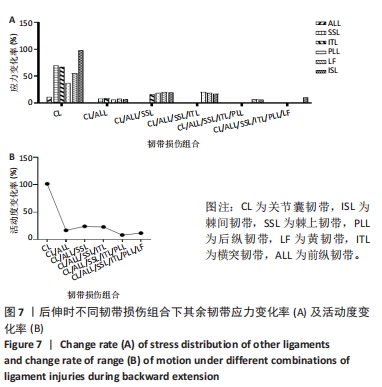
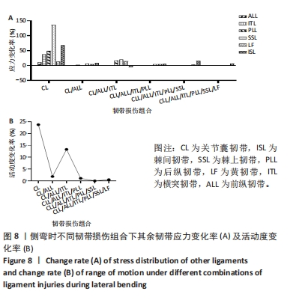
侧弯情况下,按应力由大到小顺序依次进行韧带的去除,去除韧带的6个组合为:完整韧带、关节囊韧带、关节囊韧带/前纵韧带、关节囊韧带/前纵韧带/横突韧带、关节囊韧带/前纵韧带/横突韧带/后纵韧带、关节囊韧带/前纵韧带/横突韧带/后纵韧带/棘上韧带、关节囊韧带/前纵韧带/横突韧带/后纵韧带/棘上韧带/黄韧带。图8A应力变化率显示,横突韧带、后纵韧带、棘上韧带、棘间韧带都是在去除关节囊韧带后应力变化率最大,黄韧带在去除横突韧带后应力变化率最小;棘间韧带的应力变化率在去除横突韧带后呈现轻微减小状态,减小了5.619%,但与此同时棘上韧带给了较大的应力补偿。图8B的活动度变化率显示,在去除关节囊韧带后,活动度变化率最大,其次是去除横突韧带后,活动度变化率也有较大的变化。"
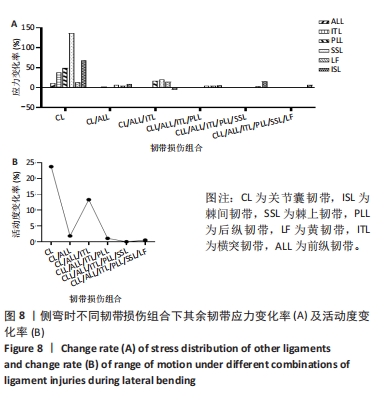
| [1] 文毅,苏峰,刘肃,等.L_(4-5)椎体有限元模型建立及退变椎间盘力学分析[J].中国组织工程研究,2019,23(8):1222-1227. [2] 徐玉东,王建红.人体解剖生理学[M].北京:人民卫生出版社, 2007:31-34. [3] 孙祥耀,鲁世保,张庆明,等.腰椎退行性疾病手术治疗的有限元建模研究进展及相关问题的述评[J].中国骨与关节杂志,2023, 12(4):241-247. [4] PANJABI MM, WHITE AA 3RD. Basic biomechanics of the spine. Neurosurgery. 1980;7(1):76-93. [5] 柏树令.系统解剖学[M].7版.北京:人民卫生出版社,2008. [6] HUISKES R,CHAO EYS,胡家栋.骨科生物力学有限元分析头10年工作综述[J].力学进展,1986(1):98-34. [7] 赵崇程.基于“筋骨并重”理论的脊柱内镜下切除部分腰椎后纵韧带的有限元研究[D].石家庄:河北中医学院,2021. [8] PIZONES J, IZQUIERDO E, SANCHEZ-MARISCAL F, et al. Sequential damage assessment of the different components of the posterior ligamentous complex after magnetic resonance imaging interpretation: prospective study 74 traumatic fractures. Spine. 2012;37:E662-E667. [9] RIHN JA, YANG N, FISHER C, et al. Using magnetic resonance imaging to accurately assess injury to the posterior ligamentous complex of the spine: a prospective comparison of the surgeon and radiologist. J Neurosurg Spine. 2010;12:391-396. [10] LI Y, SHEN Z, HUANG M, et al. Stepwise resection of the posterior ligamentous complex for stability of a thoracolumbar compression fracture: An in vitro biomechanical investigation. Medicine. 2017;96: e7873. [11] 吴聪聪.胸腰段脊柱后方韧带复合体序贯损伤对其稳定性的有限元分析[D].温州:温州医科大学,2019. [12] PINTAR FA, YOGANANDAN N, MYERS T. Biomechanical properties of human lumbar spine ligaments. J Biomech. 1992;25(11):1351-1356. [13] GUO LX, LI WJ. A biomechanical investigation of thoracolumbar burst fracture under vertical impact loads using finite element method. Clin Biomech. 2019;68:29-36. [14] 黎珂宇.基于有限元法的人体腰椎力学分析及其应用研究[D].南京:南京航空航天大学,2019. [15] 李民,周灵,汪桂珍,等.不同腰椎生理曲度下牵引的三维有限元分析[J].中国组织工程研究,2020,24(20):3162-3167. [16] CHOSA E, TOTORIBE K, TAJIMA N. A biomechanical study of lumbar spondylolysis based on a three-dimensional finite element method. J Orthop Res. 2004;22(1):158-163. [17] EZQUERRO F, SIMÓN A, PRADO M, et al. Combination of finite element modeling and optimization for the study of lumbar spine biomechanics considering the 3D thorax–pelvis orientation. Med Eng Phys. 2004; 26(1):11-22. [18] GOTO K, TAJIMA N, CHOSA E, et al. Mechanical analysis of the lumbar vertebrae in a three-dimensional finite element method model in which intradiscal pressure in the nucleus pulposus was used to establish the model. J Orthop Sci. 2002;7(2):243-246. [19] 张文,王兰,施勤,等.腰椎行椎间孔入路椎间融合术固定的有限元分析[J].医用生物力学,2014,29(5):405-410. [20] RASTEGAR S, ARNOUX PJ, WANG XY, et al. Biomechanical analysis of segmental lumbar lordosis and risk of cage subsidence with different cage heights and alternative placements in transforaminal lumbar interbody fusion. Comput Methods Biomech Biomed Engin. 2020;23(9):456-466. [21] 苏晋,赵文志,陈秉智,等.建立全腰椎有限元接触模型[J].医用生物力学,2010,25(3):200-205. [22] 刘治华,徐新伟,管文浩,等.腰椎有限元模型的建立与不同角度牵引条件下的仿真研究[J]. 郑州大学学报(医学版),2014(1): 119-122. [23] YOGANANDAN N, KUMARESAN S, VOO L, et al. Finite element applications in human cervical spine modeling. Spine. 1996;21(15):1824-1834. [24] QIN Y, ZHAO B, YUAN J, et al. Does Cage Position Affect the Risk of Cage Subsidence After Oblique Lumbar Interbody Fusion in the Osteoporotic Lumbar Spine: A Finite Element Analysis. World Neurosurg. 2022;161: e220-e228. [25] 颜文涛,赵改平,方新果,等.人体腰椎L_(4~5)节段有限元建模及分析[J].生物医学工程学杂志,2014,31(3):612-618. [26] 方新果,赵改平,王晨曦,等.基于CT图像腰椎L4~L5节段有限元模型建立与分析[J].中国生物医学工程学报,2014,33(4):487-492. [27] 王宏卫,刘新宇,万熠.人体腰椎L_4-L_5段有限元模型建立及力学有效性验证[J].医学与哲学(B),2017,38(5):50-53. [28] SCHULTZ AB, WARWICK DN, BERKSON MH, et al. Mechanical properties of human lumbar spine motion segments part 1: responses in flexion, extension, lateral bending, and torsion. J Biomech Eng. 1979;101:46-52. [29] GILLESPIE KA, DICKEY JP. Biomechanical role of lumbar spine ligaments in flexion and extension: Determination using a parallel linkage robot and a porcine model. Spine. 2004;29(11):1208-1216. [30] PANJABI MM, GOEL VK, TAKATA K. Physiologic strains in the lumbar spinal ligaments. An in vitro biomechanical study 1981 Volvo Award in Biomechanics. Spine. 1982;7(3):192-203. [31] 高素荷. 网格划分密度与有限元求解精度研究[C].//第十五届全国机械设计年会论文集. 2010:161-163,168. [32] ASANO S, KANEDA K, UMEHARA S, et al. The mechanical properties of the human L4-5 functional spinal unit during cyclic loading. The structural effects of the posterior elements. Spine. 1992;17(11):1343-1352. [33] WIDMER J, CORNAZ F, SCHEIBLER G, et al. Biomechanical contribution of spinal structures to stability of the lumbar spine-novel biomechanical insights. Spine J. 2020;20(10):1705-1716. [34] HEUER F, SCHMIDT H, KLEZL Z, et al. Stepwise reduction of functional spinal structures increase range of motion and change lordosis angle. J Biomech. 2007;40:271-280. [35] 李银倩,吕杰,王多多,等.三维有限元法分析前纵韧带对腰椎生物力学的影响[J].生物医学工程学进展,2023,44(2):176-183. [36] ELLINGSON AM, SHAW MN, GIAMBINI H, et al. Comparative role of disc degeneration and ligament failure on functional mechanics of the lumbar spine. Comput Methods Biomech Biomed Engin. 2016; 19(9/12):1009-1018. [37] KUGA N, KAWABUCHI M. Histology of intervertebral disc protrusion: an experimental study using an aged rat model. Spine. 2001;26(17):379-384. [38] FUNG YC. Biorheology of soft tissues. Biorheology. 1973;10(2):139-155. [39] SHIN JH, WANG S, YAO Q, et al. Investigation of coupled bending of the lumbar spine during dynamic axial rotation of the body. Eur Spine J. 2013; 22(12):2671-2677. [40] 高旭,邢文华.有限元分析法在脊柱外科领域的应用[J].中国组织工程研究,2023,27(18):2921-2927. [41] ZHANG Q, CHON T, ZHANG Y, et al. Finite element analysis of the lumbar spine in adolescent idiopathic scoliosis subjected to different loads. Comput Biol Med. 2021;136:104745. [42] DUPUIS S, FORTIN C, CAOUETTE C, et al. Global postural re-education in pediatric idiopathic scoliosis: a biomechanical modeling and analysis of curve reduction during active and assisted self-correction. BMC Musculoskelet Disord. 2018;19(1):200. |
| [1] | Bai Chen, Yang Wenqian, Meng Zhichao, Wang Yuze. Strategies for repairing injured anterior cruciate ligament and promoting graft healing [J]. Chinese Journal of Tissue Engineering Research, 2024, 28(9): 1457-1463. |
| [2] | Li Zhifei, Yang Yin, Chen Hualong, Liang Qinqiu, Zhong Yuanming, Zhang Yisheng. Finite element analysis of the correlation between tilt angle of titanium cage and postoperative subsidence of titanium cage after anterior subtotal cervical corpectomy, decompression and fusion [J]. Chinese Journal of Tissue Engineering Research, 2024, 28(9): 1313-1319. |
| [3] | Chen Mengmeng, Bao Li, Chen Hao, Jia Pu, Feng Fei, Shi Guan, Tang Hai. Biomechanical characteristics of a novel interspinous distraction fusion device BacFuse for the repair of lumbar degenerative disease [J]. Chinese Journal of Tissue Engineering Research, 2024, 28(9): 1325-1329. |
| [4] | Liang Cheng, Zhang Linqi, Wang Guan, Li Wen, Duan Ke, Li Zhong, Lu Xiaobo, Zhuo Naiqiang. Finite element and biomechanical analysis of different implants in repair for unilateral unstable pelvic posterior ring injury [J]. Chinese Journal of Tissue Engineering Research, 2024, 28(9): 1336-1341. |
| [5] | Yang Junliang, Lu Tan, Xu Biao, Jiang Yaqiong, Wang Fucheng. Three-dimensional finite element analysis of effects of partial anterior cruciate ligament rupture on knee joint stress [J]. Chinese Journal of Tissue Engineering Research, 2024, 28(9): 1347-1353. |
| [6] | Weng Rui, Lin Dongxin, Guo Haiwei, Zhang Wensheng, Song Yuke, Lin Hongheng, Li Wenchao, Ye Linqiang. Abnormal types of intervertebral disc structure and related mechanical loading with biomechanical factors [J]. Chinese Journal of Tissue Engineering Research, 2024, 28(9): 1436-1442. |
| [7] | Xiaheida·Yilaerjiang, Nijiati·Tuerxun, Reyila·Kuerban, Baibujiafu·Yelisi, Chen Xin. Three-dimensional finite element analysis of the distribution pattern of stress in bone tissues with different characteristics [J]. Chinese Journal of Tissue Engineering Research, 2024, 28(8): 1277-1282. |
| [8] | Wang Qiang, Li Shiyun, Xiong Ying, Li Tiantian. Biomechanical changes of the cervical spine in internal fixation with different anterior cervical interbody fusion systems [J]. Chinese Journal of Tissue Engineering Research, 2024, 28(6): 821-826. |
| [9] | Wei Yuanbiao, Lin Zhan, Chen Yanmei, Yang Tenghui, Zhao Xiao, Chen Yangsheng, Zhou Yanhui, Yang Minchao, Huang Feiqi. Finite element analysis of effects of sagittal cervical manipulation on intervertebral disc and facet joints [J]. Chinese Journal of Tissue Engineering Research, 2024, 28(6): 827-832. |
| [10] | Zhang Rui, Wang Kun, Shen Zicong, Mao Lu, Wu Xiaotao. Effects of endoscopic foraminoplasty and laminoplasty on biomechanical properties of intervertebral disc and isthmus [J]. Chinese Journal of Tissue Engineering Research, 2024, 28(6): 833-839. |
| [11] | Kang Zhijie, Cao Zhenhua, Xu Yangyang, Zhang Yunfeng, Jin Feng, Su Baoke, Wang Lidong, Tong Ling, Liu Qinghua, Fang Yuan, Sha Lirong, Liang Liang, Li Mengmeng, Du Yifei, Lin Lin, Wang Haiyan, Li Xiaohe, Li Zhijun. Finite element model establishment and stress analysis of lumbar-sacral intervertebral disc in ankylosing spondylitis [J]. Chinese Journal of Tissue Engineering Research, 2024, 28(6): 840-846. |
| [12] | Zhang Min, Peng Jing, Zhang Qiang, Chen Dewang. Mechanical properties of L3/4 laminar decompression and intervertebral fusion in elderly osteoporosis patients analyzed by finite element method [J]. Chinese Journal of Tissue Engineering Research, 2024, 28(6): 847-851. |
| [13] | Xue Xiaofeng, Wei Yongkang, Qiao Xiaohong, Du Yuyong, Niu Jianjun, Ren Lixin, Yang Huifeng, Zhang Zhimin, Guo Yuan, Chen Weiyi. Finite element analysis of osteoporosis in proximal femur after cannulated screw fixation for femoral neck fracture [J]. Chinese Journal of Tissue Engineering Research, 2024, 28(6): 862-867. |
| [14] | Huang Peizhen, Dong Hang, Cai Qunbin, Lin Ziling, Huang Feng. Finite element analysis of anterograde and retrograde intramedullary nail for different areas of femoral shaft fractures [J]. Chinese Journal of Tissue Engineering Research, 2024, 28(6): 868-872. |
| [15] | Wang Mingming, Zhang Zhong, Sun Jianhua, Zhao Gang, Song Hua, Yan Huadong, Lyu Bin. Finite element analysis of three different minimally invasive fixation methods for distal tibial fractures with soft tissue injury [J]. Chinese Journal of Tissue Engineering Research, 2024, 28(6): 879-885. |
| Viewed | ||||||
|
Full text |
|
|||||
|
Abstract |
|
|||||


